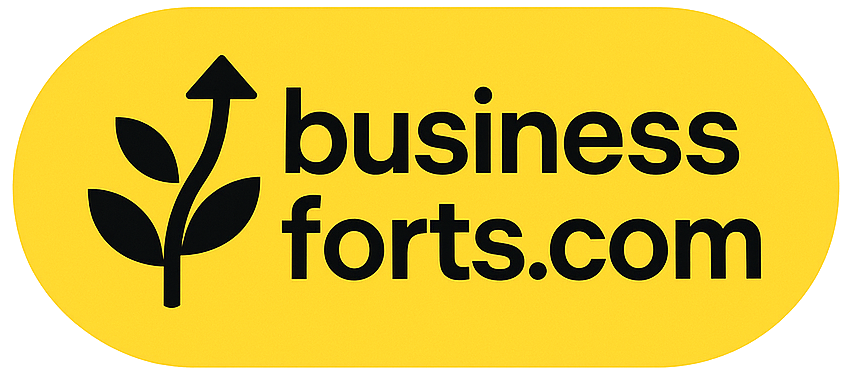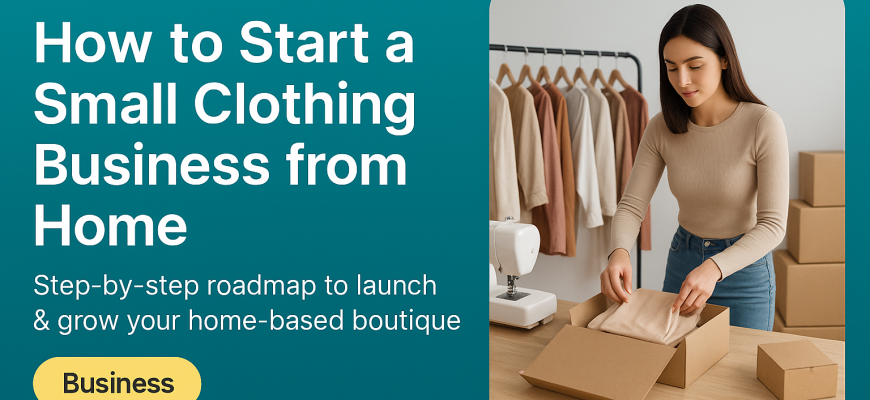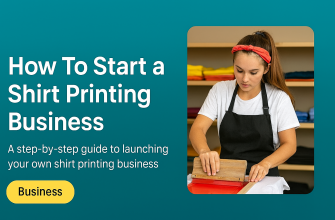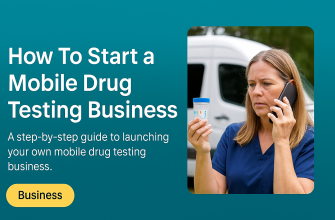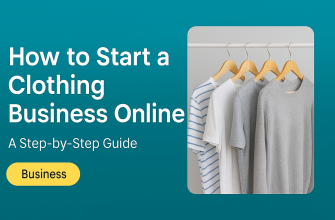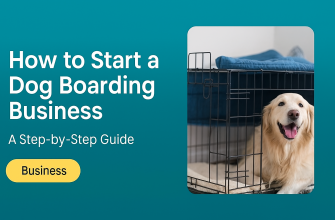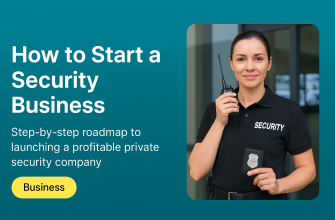Starting a clothing business from home is an exciting way to turn your passion for fashion into profit – and many women are doing it successfully. In the U.S. alone, women own over 12 million businesses, employing more than 10 million workers The fashion ecommerce market is booming (projected to reach $1.2 trillion by 2027), meaning there’s plenty of opportunity for new brands. As a business coach for women entrepreneurs, I’ve seen first-hand how a great idea and determination can grow into a thriving boutique. This comprehensive guide will walk you through each step – from planning and branding to production, marketing, and sales (both online and offline). By the end, you’ll have a clear roadmap to confidently launch your own home-based clothing venture.
- Step 1: Research Your Market and Refine Your Business Idea
- Step 2: Handle the Legal and Administrative Basics
- Step 3: Develop Your Brand Identity
- Step 4: Set Up Your Home Workspace and Production Process
- Step 5: Source Materials and Suppliers
- Step 6: Build Your Online Presence (Website & Social Media)
- Step 7: Sell Through Multiple Channels – Online and Offline
- Online Sales Channels
- Local and Offline Sales Opportunities
- Step 8: Market and Promote Your Clothing Business
- Step 9: Manage Your Finances and Grow Sustainably
- You’ve Got This!
Step 1: Research Your Market and Refine Your Business Idea
Every successful business starts with solid research and a clear niche. Before you sketch designs or build a website, take time to understand the market and where your brand will fit.
-
Perform Market Research: Study the clothing industry to learn about your potential competitors, target customers, and current fashion trends. The better you know the landscape, the higher your chances of success. Use tools like Google Trends to see what styles or keywords are trending, and browse fashion reports or forums to spot opportunities. Also read customer reviews of similar products to learn what people love or what problems they have – your business can aim to fill those gaps.
-
Define Your Niche: Rather than trying to sell “anything for anyone,” focus on a specific niche that you understand well. A niche is a targeted segment of customers with a common interest or need. For example, you might specialize in fitness apparel for new moms, vintage-inspired office wear, or eco-friendly toddler clothes. The more specific your niche, the easier it is to stand out and attract loyal customers. Niche brands face less competition and can build a stronger identity. Choose a niche that genuinely interests you and aligns with your expertise – you’ll enjoy your work more and serve your customers better.
-
Validate Your Idea: Once you have a niche and product idea, validate it. Talk to potential customers (friends, social media groups, etc.) about your concept and get feedback. You could even create a few prototype pieces and see how people respond. This doesn’t need to be a full production run – a small test can save you from investing in a product that might need tweaks. Ensure there’s real demand for what you plan to offer.
-
Outline a Business Plan: Don’t skip the business planning stage. A well-thought-out business plan will be your roadmap. It should define your target market, your unique value proposition (what makes your clothing special), and how you’ll operate and make money. Successful owners don’t “wing it” – they map out where they want the business to go and how to achieve those goals. Your plan doesn’t have to be long or formal if it’s just for you, but it should cover: startup budget, pricing strategy, sales channels, marketing plan, and projected expenses vs. income. If you need help, there are plenty of free business plan templates and resources online to guide you.
-
Choose a Business Model: Decide how you will produce and deliver your products. Will you make the clothing yourself (hand-sewing or using a machine for each piece)? Will you use print-on-demand or dropshipping to avoid holding inventory? Modern business models like print-on-demand (POD) allow you to partner with a supplier who prints your designs on apparel and ships it for you, so you don’t need to invest in fabric or inventory upfront. Alternatively, you might work with a local seamstress or small factory for production once you have demand. Outline these choices in your plan. Each model has pros and cons: for instance, handmade gives you full control over quality but can be time-intensive, whereas POD/dropshipping let you start with minimal investment but at lower profit margins per item. Pick the approach that fits your skills, budget, and vision.
Taking these steps will ground your business in reality. Market knowledge helps you make informed decisions at every turn – from what styles to produce, to how to price and where to sell. As you do your research, keep notes on ideas that excite you and problems you could solve. This research and planning is the foundation for everything to come.
Step 2: Handle the Legal and Administrative Basics
Before you can start selling, you’ll need to take care of some important administrative tasks. Setting up the business properly from the start will save headaches later and legitimize your operation.
-
Choose a Business Name: Pick a unique, memorable name that reflects your brand’s style and appeals to your target market. Make sure the name isn’t already in use (search online and check business name databases in your country). This name will go on your website, social media, and labels, so take your time to get it right.
-
Register Your Business: Formally register your business with local authorities to make it official. This could mean registering as a sole proprietorship, LLC, or other entity depending on your location and needs. Each country (and state/province) has different rules, so find out what’s required. Doing this ensures you comply with regulations and can operate without legal troubles. It might be as simple as filling out a form and paying a small fee, or a bit more complex if you choose to incorporate – research what fits your situation.
-
Obtain Necessary Licenses/Permits: Check if you need any specific licenses to run a home-based business or to sell clothing. Some jurisdictions require a general business license, and if you use your home for work, a home occupancy permit. If you plan to sell at craft fairs or markets, you may need a sales tax permit or vendor license. Ensuring you have these in place will keep you on the right side of the law.
-
Set Up Business Banking and Accounting: Open a separate bank account for your business. This keeps your personal finances distinct and makes bookkeeping much easier. Track all your expenses (materials, shipping, website fees, etc.) and income from day one. You can use simple accounting software or even a spreadsheet to start. The key is to record everything. Many first-time entrepreneurs underestimate the importance of tracking finances – but good records will show you if you’re profitable and simplify things come tax time. If accounting isn’t your strength, consider hiring a part-time bookkeeper or using affordable apps to help. Also, set aside a portion of revenue for taxes as you go, so you’re not caught off guard by tax bills.
-
Consider Legal Structure and Liability: Decide on the business structure that’s best for you (sole proprietor vs. LLC, etc.). A simpler structure like sole proprietorship or partnership might be easiest to start, but it doesn’t separate personal and business liability. Many small business owners opt to form an LLC to protect personal assets – it’s worth researching and perhaps consulting a legal professional to choose the right structure. Additionally, look into business insurance, especially if customers will visit your home or if you’re producing items (product liability insurance can protect you in case of issues with your products).
-
Understand Your Obligations: Every country has different regulations, but you should educate yourself on basics like collecting sales tax (for online sales, platforms can sometimes help with this), reporting business income to tax authorities, and any product safety regulations. For example, if you make children’s clothing in the US, there are specific safety standards and labelling requirements. Don’t be intimidated – usually small-scale home businesses have straightforward rules, and there are many guides from government websites or small business associations. When in doubt, consult a mentor, join entrepreneur groups, or seek professional advice to ensure you’re compliant.
Preparing this “business backend” might not be the fun part of entrepreneurship, but it is essential. Completing these steps gives you a solid legal footing and peace of mind to focus on the creative side of your business. Plus, when you handle the admin side professionally, you’ll feel a boost of confidence – you’re not just doing a hobby, you’re running a real business!
Step 3: Develop Your Brand Identity
Your brand is the personality of your business – it’s what will make your clothing line memorable and appealing to customers. Building a strong brand identity goes far beyond designing a pretty logo.
Define Your Brand Fundamentals: Start by clarifying your brand mission, values, and story. Ask yourself: What does my brand stand for? Maybe you value sustainability, body positivity, or empowering women through fashion. Maybe your story is that you’re a mom who started sewing at the kitchen table or a designer inspired by your cultural heritage. These elements become the soul of your brand and should shine through everything you do. Write down a short mission statement (even just for yourself) encapsulating what you want to offer and why.
Create Visual Identity: With your brand’s core defined, craft the visual elements:
-
Name & Logo: If you haven’t already, finalize your business name. Then design a logo that represents your style. It could be a simple wordmark (just your business name in a stylized font) or include an icon. There are free or low-cost tools like Canva to help create a logo if you’re not a designer. Ensure it’s clear, professional, and looks good in various sizes (on a website, clothing labels, social media profiles, etc.).
-
Colors and Fonts: Choose 1-3 main colors for your brand and one or two fonts to use consistently. This creates a cohesive look. For example, if you sell calming loungewear, you might pick soft pastel colors and a clean, modern font. If it’s a bold streetwear line, maybe high-contrast colors and edgy typography. Consistency is key – use the same visual style across your website, packaging, and social media to build recognition.
-
Brand Voice: Determine how you will communicate in text. Are you friendly and casual, professional and authoritative, or playful and witty? The tone should resonate with your audience. As a coach writing this, my tone here is motivational and informative. For your brand, you might adopt an empowering tone if your line is about confidence, or a nurturing tone for baby clothes, etc.
Tell Your Story: People love brands with authentic stories. Don’t be afraid to share yours. For instance, if you started this business to solve a problem (like finding stylish but comfortable hijabs, or plus-size fashions that are actually trendy), share that on your “About Us” page or product descriptions. Storytelling creates an emotional connection. It can be as simple as: “I started [Brand Name] because I believe [your vision]. After [your experience that led here], I decided to create my own line of clothing that [what makes it special].” This sets you apart from generic big-box retailers.
Build Brand Guidelines: As your business grows, having a simple brand style guide helps keep everything consistent. Jot down your chosen colors (hex codes), fonts, tone of voice, and even guidelines for photography style (maybe you want all product photos to have a clean white background, or all lifestyle shots to have a warm filter). Consistency is the thread that will make your brand identifiable at a glance. For example, fashion entrepreneur Sarah Donofrio notes that a recognizable brand identity – consistent across social media, online store, and designs – is crucial to stand out.
Engage on Social Media as a Brand: Start showcasing your brand’s personality online. Use social media (Instagram in particular) to build a lifestyle around your brand. Post not only product images, but also content that inspires your target audience: mood boards, behind-the-scenes peeks of your design process, quotes or stories that align with your brand values, etc. Injecting your own personality and story makes the brand relatable. Remember, social media is about building a community, not just advertising. Consistency is key – “you have to post every day, but it also has to be interesting,” advises Sarah Donofrio, who mixes product posts with travel inspiration and even insights from her business journey. You don’t have to post daily if that’s overwhelming, but do show up regularly (e.g., a few times a week) so followers remember you.
In short, think of your brand as a person: What does she stand for? How does she speak and dress? What impression does she leave? Craft that image and carry it through everything – from your clothing designs to your Instagram captions. A strong brand identity will attract your ideal customers and turn them into fans who feel connected to your mission.
Step 4: Set Up Your Home Workspace and Production Process
One of the perks of a home-based business is that you don’t need a fancy office or storefront – but you do need a functional workspace and a plan for how you’ll create your products. Whether you’re hand-making garments or coordinating production with a partner, getting your “maker” process in order is crucial.
Organize Your Home Studio: Dedicate a specific area in your home for your business. It could be a spare room, part of your garage, or even a well-organized corner of your living room. Set it up to accommodate your workflow from start to finish. For example, if you sew, you might have a cutting table, a sewing machine station, and shelves or bins for fabric and supplies. If you’re doing printing (like screen printing T-shirts or packing orders), ensure you have a large flat surface and storage for blanks and finished inventory. Good lighting and an ergonomic chair can make a big difference when you’re working long hours. Storage is also key – use shelves, clear containers, garment racks, or pegboards to keep things tidy and easy to find. Not only will an organized space save you time, it will keep you motivated and inspired to create in it.
-
Tip: If your home space is very limited, look into shared studios or maker spaces in your community. Some cities have co-working spaces for creatives or incubator programs for fashion startups where you can occasionally access larger equipment or just get out of the house for a productivity boost. But to start, your kitchen table or a small desk can absolutely work – many brands began in tiny home corners!
Start Small with Production: In the early days, you will likely be producing in small volumes – which is perfectly fine. In fact, starting with small batches or made-to-order production is a smart way to manage costs and test your products. Many successful clothing entrepreneurs begin by making products themselves or with one helper, and only later move to larger manufacturing. Unless you have overwhelming demand right off the bat, you don’t need a factory from day one. Focus on mastering the quality and process on a small scale first.
-
Make Sample Products: Create a few sample items or a “mini-collection” of your designs. This accomplishes two things: (1) You’ll have physical products to show (and photograph) for your shop launch, and (2) you gain a better understanding of what it takes to produce each piece. Fashion designers often make their own samples by hand for this reason – it gives insight into production challenges and costs. For instance, if you design a dress and sew a prototype, you might discover a simpler way to construct it that will save time or notice that a certain fabric is difficult to work with. That knowledge is gold before you scale up.
-
Streamline Your Process: As you produce those first pieces, think about efficiency and consistency. If you find yourself making the same item repeatedly, set up a workflow. For example: cut all pieces first, then sew in batches, then finish details. Small tweaks like organizing your tools, pre-sorting sizes, or creating templates/patterns can speed things up. Even though you’re at home, treat it a bit like a mini production line. This will help a lot if orders increase.
-
Quality Control: Develop a keen eye for quality from the start. Check each item you make for loose threads, proper sizing, sturdy seams, etc. When you’re the one making or overseeing production, it’s easier to maintain high quality – and quality is what will earn you repeat customers. Create a simple checklist for yourself to review each product before it goes out. Your brand’s reputation rests on delivering great products, so get this right early.
Consider Outsourcing (When Needed): As your business grows, you might reach a point where making everything yourself is not feasible. The good news is, there are many ways to scale production:
-
You could hire a part-time assistant or contract a local seamstress to help with sewing while you still manage it in-house.
-
You might find a local small-batch manufacturer. Websites like Maker’s Row or MFG connect small businesses with local factories that take low-order quantities.
-
Print-on-demand partners can handle printing/fulfillment of certain products (e.g., you focus on sewing custom skirts, but use POD for printed t-shirts or tote bags to expand your line).
-
Eventually, an overseas factory is an option for large orders, but that’s something to consider much later when you have steady demand.
In the beginning, keeping production in-house or locally controlled gives you agility. You can tweak designs or fix issues quickly. Fashion entrepreneur Sarah Donofrio recalls that initially her clothing line was produced primarily by her own hands; as demand grew she gradually outsourced some tasks to local sewists, and only later moved to factory production as her time was better spent on design and brand-building. You can follow a similar path: walk before you run. Use the early phase to refine your products and workflow.
Ensure a Smooth Workflow at Home: Make your workspace as efficient as possible. Arrange it so that it’s easy to move from one task to the next (for example, cutting table near the sewing machine, packing station near where you store finished inventory). Remove clutter that’s not related to your business to minimize distractions. Since you’re at home, set boundaries – maybe establish “business hours” or a routine, so family members know when you’re working. Treating your business with professionalism in the home environment can boost your productivity.
By setting up a functional workspace and manageable production process, you’re creating the engine that will drive your business. Even if it’s just you sewing late at night after the kids are asleep, that humble setup is the start of something great. Many brands have literally grown from a kitchen table to a full studio – it’s all about starting where you are and being willing to improve step by step.
Step 5: Source Materials and Suppliers
The materials you use will have a huge impact on your product quality, costs, and brand reputation. Sourcing is about finding the right components for your clothing – be it fabric, trims, blanks (blank t-shirts, hoodies, etc., if you’re printing designs), or packaging – at the right price and quality. Here’s how to approach sourcing when you’re a home-based startup:
Identify What You Need: Make a list of all materials and supplies required to create your products. This might include:
-
Fabric (by the yard or bolts) or pre-made blank apparel if you’re customizing.
-
Sewing supplies like thread, zippers, buttons, elastic, etc.
-
Labels for your brand (you can order custom woven labels to sew into garments, or printed tags).
-
Packaging materials: poly mailers or boxes, tissue paper, thank-you cards, etc. (Unboxing is part of the customer experience, so plan how you’ll present your product when it arrives).
-
Shipping supplies: a scale, postage printer or clear tape and labels if using hand-written, etc.
-
If printing designs: transfer paper, inks, or access to printing equipment.
Having this list helps you systematically find sources for each item.
Research Suppliers: Start looking for places to buy your materials. You have several avenues:
-
Local Retail Stores: For a very small start, you might simply buy fabric and supplies from a local fabric store (like JoAnn in the US or independent shops). The cost per unit will be higher than wholesale, but it’s convenient and great for initial prototyping or small batches.
-
Wholesale Suppliers: When you’re ready to buy larger quantities, seek wholesalers. Many cities have a garment/fabric district (like Los Angeles or New York) where suppliers sell in bulk. You can also find wholesalers online. There are websites and directories for textile wholesalers. For example, if you need organic cotton fabric, you might search for “organic cotton wholesale supplier”.
-
Global Marketplaces: Platforms like Alibaba or Indiamart connect you with manufacturers and suppliers worldwide. This can be useful for finding bulk fabric or even a manufacturer for your designs. One entrepreneur, starting a maternity activewear line, conducted extensive research and sourced her suppliers from Alibaba when launching her business. If you go this route, be sure to order samples first to verify quality, and start with small orders to build trust.
-
Print-On-Demand Companies: If you’re using POD, your “suppliers” are essentially those companies (Printify, Printful, etc.) – you’ll be using their blank products. Research which provider has the types of garments you want (styles, sizes, colors) and compare their quality/reviews. Order a sample from them to inspect fabric feel and print quality before committing.
-
Other Makers: Sometimes, you can collaborate with other small businesses. For example, if you make dresses but want to include a hand-knitted beanie in your collection, you might source those from a local knitter. Networking in maker communities can lead to supplier relationships too.
Compare Cost and Quality: When you find multiple options for a material, compare them. Get quotes for prices and minimum order quantities. As a small business, you might not afford to buy huge rolls of fabric initially, but some wholesalers have low minimums or “jobber” services (selling leftovers from mills) which is perfect for startups. Also, compare quality – a cheaper fabric might not drape as nicely or might feel rough, which could hurt your product appeal. Always request swatches or samples. Most fabric suppliers will send swatches for little or no cost. For blanks (like blank shirts), order one or two from different companies and do a wash test (see how it holds up after laundering). Investing time in sampling will save you from costly mistakes with bulk buys.
Build Relationships: If you find a good supplier, build a relationship with them. Being friendly and professional can sometimes get you better service, advice on what sells, or flexibility on order sizes. Remember, as your business grows, you’ll likely stick with key suppliers for consistency. Treat them as partners. Pay on time, communicate clearly, and they’ll be more inclined to support your small business needs.
Sourcing for Brand Consistency: Don’t forget that your materials should align with your brand values. If you market your brand as eco-friendly, ensure your fabrics are sustainably sourced (organic, recycled, etc.) or that you use eco-packaging. If your brand is all about luxury, you’ll want high-end fabrics. Your sourcing choices should reflect the promise you make to customers. For example, Natalie, the founder of a maternity activewear brand, wanted functional and affordable clothing for moms; she did her research and found suppliers via Alibaba to meet her quality needs and price point, then reached her customers through community groups on Facebook. This shows how aligning sourcing with brand vision (affordable activewear, in her case) and smart research can set you up for success.
Stay Organized: Keep track of supplier contacts, prices, and order details in a spreadsheet or notebook. When you reorder or scale up, this information will be very handy. Note lead times (how long it takes to get materials) so you can plan your production schedule accordingly.
Lastly, be resourceful and persistent. In the beginning, you might not know where to find that perfect fabric or how to get labels made, but answers can be found by asking in entrepreneur forums, attending small business fairs, or simply Googling and emailing companies. Sourcing is like a treasure hunt – with patience and effort, you’ll find the gems you need for your clothing line.
Step 6: Build Your Online Presence (Website & Social Media)
In today’s digital world, having an online presence for your brand is non-negotiable – especially if you’re running a business from home. Your online storefront and social media profiles will be the primary way customers find and interact with your brand. This step is all about setting up your digital shop window and making it inviting.
Create an Online Store or Platform: Decide where you will sell your products online. You have a few popular options:
-
Etsy: A great starting point for many handmade or small-scale sellers. Etsy is a marketplace known for crafts and unique items, so customers are already there looking for things like yours. It’s easy to set up, and you get the benefit of Etsy’s existing traffic. However, you will compete with other sellers and pay listing and transaction fees.
-
Shopify or Other E-commerce Website: If you want more control over branding and customer experience, setting up your own website is the way to go. Shopify is a user-friendly platform that lets you create a professional online store without needing advanced tech skills. It offers themes (design templates) and handles payments, etc. There is a monthly fee, but you have full brand control – your store, your URL. Other options include WooCommerce (for WordPress sites) or BigCommerce, but Shopify is very popular among small apparel brands. With your own site, note that you’ll need to drive traffic to it (through marketing), since you won’t have the built-in marketplace browsing that Etsy provides.
-
Online Marketplaces (Amazon Handmade, etc.): Amazon has a Handmade section and other sites like eBay or Depop could be avenues depending on your product. These can broaden your reach, but each has its own fee structure and brand limitations. You might use them as supplemental channels.
-
Social Media Shops: Platforms like Instagram and Facebook now allow direct shopping. For example, you can set up an Instagram Shop so users can click on your post and buy the item. Usually, this still links to a checkout on an e-commerce platform (like Shopify or your Facebook Shop), but it reduces friction for customers. If your audience is very Instagram-active, this is worth doing. Facebook Marketplace and groups are another simple way to post items for local sale or auction style, but for a real brand, a dedicated shop is better.
Many businesses actually use a combination: for instance, sell on their own website and also list on Etsy to capture those shoppers, and maybe list select items on Amazon. Early on, you might focus on one primary channel to avoid spreading yourself too thin. The good news is, you can start on one (say, Etsy) and later expand to your own site once you have an audience, or vice versa.
Set Up Your Website Professionally: Whichever route you choose, make sure your online storefront looks clean and professional:
-
Use high-quality photos of your products (more on this in marketing, but it’s worth noting here – photos can make or break an online sale).
-
Write clear, persuasive product descriptions. Highlight the features (e.g., fabric, fit) and the benefits (how it makes the customer feel or solve a need). Also share your care instructions, sizing info, and a bit of the story if appropriate (e.g., “handmade with organic cotton, inspired by summer nights in Bali…”).
-
Include an “About Us” page to share your brand story and values, as discussed.
-
Make sure it’s easy for customers to navigate and purchase. Test the buying process yourself or with friends to iron out any kinks.
-
If on Etsy, fill out all sections: shop bio, policies, FAQ, etc., to build trust.
Reserve Social Media Handles: Even if you’re not ready to post a lot yet, claim your brand name on major social platforms (Instagram, Facebook, Pinterest, TikTok, Twitter if relevant). You’ll likely want to focus on 1-2 platforms where your target audience spends the most time (for fashion, Instagram is usually a top pick, and maybe TikTok or Pinterest depending on demographic). Fill out your profiles with your logo, brand description (mention your niche or tagline), and a link to your website or Etsy shop.
Instagram – Your Digital Lookbook: Instagram is incredibly important for fashion brands due to its visual nature. As of recent stats, 83% of users say they discover new products or services on Instagram, and 70% of shopping enthusiasts turn to Instagram for product discovery. This means a strong Instagram presence can directly lead customers to you. Start by posting photos of your products, but also lifestyle images (e.g., someone wearing your clothes at home or out and about), behind-the-scenes shots, mood boards, etc., to create an aesthetic feed that reflects your brand. Use relevant hashtags (e.g., #handmadeclothing, #plussizefashion, #bohoboutique – whatever fits your niche) so people can find you. Engage with the community: follow other creators, comment genuinely on posts, and respond to comments on yours. When you reach certain criteria, enable Instagram Shopping so you can tag products in your images.
Facebook and Others: If your audience skews a bit older or family-oriented, Facebook is still useful. You can create a Facebook Page for your brand and connect it to an Instagram Shop. You might also join Facebook Groups related to your niche (for instance, a group for sustainable fashion lovers or for mom entrepreneurs) – not to spam with promos, but to engage and occasionally share your journey or products when appropriate. Pinterest is excellent if your product photos are high quality – people use Pinterest like a catalog or inspiration board, and it can drive traffic to your site over time if you pin your product images (with links). TikTok has become a place where small businesses can go viral; if you’re comfortable making short videos, you could show packing orders, transformation of materials to finished product, styling tips, etc. It can humanize your brand and reach a younger audience.
Consistency and Contact: Ensure that your branding (logo, style, voice) is consistent across your site and all social media. This builds credibility. Also, make it easy for customers to contact you – list an email address (or have a contact form) on your site, and be responsive to messages or comments on social. Early on, superb customer service (like quickly answering a question about sizing) can win you a sale over a slower competitor.
Remember, your online presence is often the first impression of your business. Take the time to polish it. The effort you put into a great website and engaging social media can pay off big time, by attracting shoppers from around the world to your home-based business.
Step 7: Sell Through Multiple Channels – Online and Offline
With your online shop in place and social media humming, it’s time to sell, sell, sell! Launching your products and generating sales will likely involve a mix of online and offline channels. Each avenue has its advantages. By leveraging both, you can maximize your reach and learn which works best for you. Let’s explore these avenues:
Online Sales Channels
Your Website/Etsy Shop Launch: Officially “open” your online store. You might announce a launch date and even do a small countdown or teaser on social media to build excitement. Ensure you have a decent number of products or variations listed so the shop looks alive (even if it’s just 5-10 items to start). Consider offering a small launch promo, like a discount code for first-time buyers or free shipping for the first week, to encourage early sales.
Leverage Online Marketplaces: If you listed on Etsy or similar marketplaces, make use of their tools:
-
Etsy, for example, has search tags – use all the tags with relevant keywords so your items appear in searches. Also, Etsy ads can boost visibility if you have a small budget to test.
-
Maintain a high quality of customer service on these platforms (fast shipping, good reviews) because ratings will affect your success.
Utilize Social Commerce: As mentioned, Instagram and Facebook allow people to shop directly. Make sure to link your catalog to these platforms. That way, when you post a picture of your beautiful dress, customers can tap and see the price and click to purchase immediately. Social media is increasingly becoming a point-of-sale. You can also use features like Instagram Stories with swipe-up (if eligible, or use link stickers) to announce new arrivals or a sale.
Email and Website Marketing: If you’ve set up a website, add an email signup pop-up or footer to collect customer emails (perhaps offer a 10% discount code for subscribing). Building an email list is gold for online selling because you own that list and can directly reach people who showed interest. Send a friendly announcement email to friends/family and early sign-ups about your store launch. Down the line, you’ll send newsletters with new products or special offers to drive repeat sales.
Consider Online Market Strategies: Some home-based fashion sellers also use live sales or auctions on social media (e.g., going live on Facebook to showcase items and having people comment to purchase) – this can create urgency and a fun shopping experience. Platforms like Depop (for trendy vintage or streetwear) or Poshmark (for boutique and resale) could be explored if they fit your style; some entrepreneurs cross-list items on multiple platforms to increase exposure. Just be careful to keep inventory in sync if you do this (so you don’t sell the same one-of-a-kind item twice by accident).
Local and Offline Sales Opportunities
While online allows you to reach the world, offline channels can be fantastic for building local support and getting face-to-face feedback (plus, no shipping needed for immediate sales!). Don’t underestimate the power of in-person connections.
Pop-Up Shops: A pop-up is a temporary retail space – for example, renting a small booth or a shared retail space for a weekend or a few days. You can host a pop-up in collaboration with other local brands or at events. For instance, a local boutique might let you pop up in a corner of their store, or you could join a pop-up market event. Pop-ups create buzz and a sense of urgency (limited time to buy in person). They’re great for showcasing your products in real life so customers can feel the fabric and try things on. When you do a pop-up, make sure to promote it to your followers and local community. Take nice photos of the setup – it’s content for your social media too.
Craft Fairs and Markets: Look for artisan markets, craft fairs, or farmer’s markets in your area that allow clothing vendors. These events draw shoppers who love unique, handmade products. There’s often a booth fee, but the marketing is done by the event organizers, so you just show up with your goods. Create an attractive booth: a banner with your logo, a rack or neat table display of your clothing, mirrors if selling wearables, and perhaps a mailing list sign-up sheet or QR code for your online store (so even if people don’t buy on the spot, they can find you later). Craft fairs not only generate sales, but also give you valuable face-to-face customer interactions. You can observe which items people gravitate towards, what questions they ask (helps you refine product info), and gather emails. Many entrepreneurs start at local fairs and build a loyal following who then continue to buy online.
Friends, Family, and Word-of-Mouth: Don’t be shy about selling through your personal network, especially at the very beginning. Host a little “launch party” at your home – invite friends, neighbors, colleagues to see and shop your collection (make it fun with some snacks or tea). Even if it’s small, those first sales and feedback will encourage you. Give your friends business cards or lookbooks to share with others. Personal referrals are powerful – people love to talk about a cool new boutique a friend started. You might get your first custom orders just from word-of-mouth. Just remember to be respectful – no hard selling to friends, simply invite and let them spread the word if they like your stuff.
Consignment or Boutique Partnerships: Another local avenue is to approach small boutiques or gift shops in your area that carry products complementary to yours. For example, a local children’s boutique might carry a few of your handmade baby outfits on consignment (meaning, they display and sell them, and you get paid only when they sell, usually splitting the revenue). Some boutiques will buy wholesale from you if you can offer that. It doesn’t hurt to politely approach store owners with a short pitch and samples of your work. The worst they can say is no; but if they say yes, it can raise your brand profile and sales. Hint: target boutiques that align with your niche and size (a tiny home-based operation might fit well in a small local shop, whereas a big-box retailer is not realistic initially).
Local Community Events: Think outside the box – maybe there’s a local fashion show for emerging designers you can join, or a school/church bazaar, or even a charity event where vendors are welcome. These can be both sales opportunities and ways to network. Sometimes showcasing at a community event can get you media attention as a local business story.
Using both online and offline channels often creates a synergistic effect. For example, someone discovers you at a craft fair, follows your Instagram, later buys from your website
Using both online and offline channels often creates a synergistic effect. For example, someone might discover you at a craft fair, follow your Instagram, and then later make a purchase on your website. Likewise, an online customer in your town might be thrilled to attend a pop-up event and meet you in person. By being accessible in multiple ways, you maximize your reach and convenience for customers.
Step 8: Market and Promote Your Clothing Business
“Build it and they will come” doesn’t quite apply in the crowded world of retail. You need to actively market your clothing business to attract customers and grow your brand. Marketing might sound intimidating, but for a small home business it’s largely about connecting with your audience and getting the word out creatively. Here are key marketing strategies, especially suited for women entrepreneurs launching from home:
Social Media Marketing: Continue to leverage social platforms to their fullest:
-
Engage Regularly: Post consistently on your chosen platforms (Instagram, Facebook, TikTok, Pinterest, etc.). Show your products in use – for a clothing line, user-generated content is powerful, so encourage customers to tag you in photos wearing your designs. Repost (with permission) happy customer photos; this not only provides social proof but also builds community.
-
Content Ideas: Mix up promotional posts with valuable or relatable content. For instance, share style tips (“3 ways to style our signature blouse for work-to-weekend”), behind-the-scenes glimpses (“Sketch to Dress: watch us turn an idea into reality”), or even educational content if relevant (“Why we choose organic cotton – the impact of sustainable fabrics”). Going live on Instagram or Facebook to talk about your brand story or do a Q&A can put a face to the brand – this personal touch is something big companies struggle with, but small businesses can excel at.
-
Hashtags & Challenges: Use popular and niche hashtags to increase visibility (#WomenInBusiness, #ShopSmall, #HandmadeFashion plus those specific to your style). Participate in trending challenges or themes if they fit – e.g., a TikTok fashion challenge, or Instagram’s weekly #FridayIntroductions to re-introduce yourself as the founder.
-
Influencer and Collaborations: Identify influencers or bloggers (they don’t need to be super famous – micro-influencers with a loyal following in your niche are great) whose style aligns with your brand. You can offer to send a free product in exchange for an honest review or feature. Many women entrepreneurs have successfully grown by partnering with influencers who love their products. Make sure to research and approach politely and professionally. Also consider collaborating with complementary brands (e.g., a handmade jewelry business and your clothing line could do a joint giveaway, exposing each brand to the other’s audience).
Branding & Storytelling in Marketing: As you promote, always circle back to your brand’s story and values. Share why you started the business, what makes your process special (e.g., “made in small batches by hand,” or “inspired by my Caribbean roots”). Customers, especially those supporting small businesses, love to feel that personal connection. This storytelling approach sets you apart from fast-fashion chains.
Email Marketing: We mentioned building an email list – now, make use of it. Send a newsletter at least monthly. It can be simple: update subscribers on new products, share a customer testimonial, provide a limited-time promo code, or even a personal note about your journey (“It’s been 3 months since I launched, here’s what I’ve learned…”). Emails keep your audience engaged and drive traffic to your site. They are a direct line to people who have already shown interest by subscribing, so treat them like VIPs with insider news or first access to new collections.
Promotions and Sales: Strategically offer promotions to boost sales. Ideas include:
-
Seasonal Sales: e.g., end-of-season clearance, holiday sales (Mother’s Day special for a women’s brand, etc.).
-
Bundle Deals: If you have complementary items, offer a bundle at a slight discount (buy a top and skirt together for 10% off).
-
Referral Program: Encourage existing customers to refer a friend – perhaps they and the friend both get a discount or small gift when the friend makes a purchase.
-
Loyalty Perks: Even informally, you can surprise repeat customers with a thank-you note and a small coupon, or feature them on your social media (with their consent) as a “Customer of the Month”. These gestures build loyalty.
Networking and Community: Networking isn’t just for corporate careers – it’s valuable for entrepreneurs too. Join communities (online forums, Facebook groups, local meet-ups) of small business owners or specifically women entrepreneurs. For example, a local “women in business” meetup or an online group like Female Entrepreneur Association can provide support, ideas, and sometimes collaboration opportunities. Being active in communities can indirectly market your business as well (when people know what you do, they might refer others to you). Locally, consider talking to your Chamber of Commerce or small business development center – they often host events or spotlight local businesses, which is free publicity.
Press and PR: As you gain some traction, you might reach out to local media or bloggers for features. A human-interest story like “Local mom turns hobby into thriving online boutique” or “Teacher by day, fashion designer by night” is appealing content for newspapers or community websites. Prepare a short pitch about your story and why it’s inspiring or newsworthy (e.g., a unique angle like using zero-waste materials or empowering a certain community). Even a small feature can bring a surge of interest and traffic to your site. And getting featured in a reputable source adds credibility to your brand – you can then say “As seen in __” on your site, which impresses customers.
Paid Advertising (Optional): If you have a bit of budget, experimenting with Facebook/Instagram ads or Google ads can amplify your reach beyond your followers. Even $5-10 a day targeted to your ideal customer profile can generate new leads. For example, you can target women aged 25-45 interested in “handmade fashion” or “fitness apparel” in your country, and show them a catchy ad of your product. Start small, test different images/captions, and see if the clicks or sales from it justify the cost. Ads can be technical, so use them as a supplement once you’ve maximized free methods.
Provide Stellar Customer Service: Marketing isn’t only about promotion – it’s also every interaction a customer has with your brand. Respond promptly and kindly to inquiries (whether via email, Etsy messages, or Instagram DMs). If there’s an issue with an order, fix it with a smile. These efforts turn customers into repeat buyers and brand advocates. A happy customer will tell friends and maybe even post about you, effectively marketing for you. As a small business, you can deliver a personal touch that big companies can’t – lean into that.
In summary, marketing your home-based clothing business is an ongoing effort to increase visibility and build relationships. Be authentic, be persistent, and track what works. Over time, you’ll see your customer base grow from a trickle to a steady stream as your marketing efforts compound.
Step 9: Manage Your Finances and Grow Sustainably
Running a creative business is fun, but you have to keep an eye on the numbers to ensure it’s financially viable. Good financial management will help your business thrive in the long run and keep your stress levels down. As your own “Chief Financial Officer,” here are key pointers:
Set Pricing Strategically: Pricing your clothing isn’t just material cost + a random markup. You should factor in all costs and desired profit. Consider your cost of goods (fabric, trims, packaging), labor time (even if it’s your own labor – you deserve to be paid for your time, eventually), overhead (equipment, internet, any fees), and also market factors. Study the prices of similar products to determine an appropriate price point. If you position your brand as premium, you can charge more, but then everything (quality, branding) must align to justify it. It’s often better to start a bit higher than too low – you can run discounts if needed, but raising prices later on returning customers can be tricky. Also account for selling fees (Etsy fees, PayPal/Stripe processing fees, etc.). Aim for a healthy profit margin so that you have room to reinvest. As a simple example, if a handmade skirt costs $20 in materials and you take 2 hours to make it, you might charge $60: $20 covers materials, roughly $20 (or $10/hour) compensates your time initially, and $20 profit to reinvest or pay for your overhead. Over time, you’ll refine this, especially as you become more efficient or scale production. Use pricing calculators or formulas available for small businesses if needed.
Keep Business Books: Maintain a record of all expenses and revenue. If spreadsheets are your thing, update one regularly. Otherwise, accounting software like QuickBooks, Xero, or even a free tool Wave can link to your bank and help you categorize transactions. This is important for knowing if you’re actually profitable and for tax filing. Many small-business owners set aside a specific day each month to reconcile accounts and review finances. Since you’ve separated your bank accounts, this becomes much easier. Keep receipts (physical or digital copies) of business purchases in an organized way – there are apps to scan receipts, or just have a dedicated folder.
Monitor Cash Flow: In a product business, money can get tied up in inventory. Plan for this. For instance, you might need to invest $500 in materials for a new collection; you may not recoup that until the items sell. Always ensure you have enough cash for essential expenses (like website fees, material restocks, etc.). Try to maintain a little cushion. If you start making significant sales, remember you’ll likely need to pay self-employment taxes or income taxes on profit, so setting aside, say, 20-30% of each sale for taxes in a separate savings account is wise. That way, when tax time comes, you’re prepared.
Control Inventory and Costs: Regularly review what’s selling well and what’s not. Your data can be simple: track each style and how many you sell. If certain items are hot sellers, focus on those – maybe expand with new colors or sizes. If some products aren’t moving, consider discontinuing them or tweaking the design/price. The last thing you want is a pile of unsold stock (especially if trends move on】. To avoid overstocking, you can adopt a made-to-order or small batch approach: make a few, sell them, then make more if demand continues. It’s a balancing act – you want to have enough inventory to fulfill orders quickly, but not so much that you have cash tied up in unsold goods. Using pre-orders or waitlists for popular items can also gauge demand without full upfront production.
Budget for Growth: As you make profits, decide how much to reinvest in the business. Perhaps you allocate a certain percentage of each sale back into buying new materials, upgrading equipment (e.g., a better sewing machine or label printer), or marketing. Also pay yourself something, even if nominal at first – it is your business after all, and seeing a reward (like being able to cover a personal bill or treat yourself from business earnings) will motivate you to keep going. Many women entrepreneurs start their businesses as a side hustle; as it grows, careful financial planning lets them transition to full-time entrepreneurship. Track at what point your income might allow you to do that if that’s your goal (e.g., when your business consistently makes as much as your day job or at least covers your essential expenses).
Seek Funding if Needed (Carefully): One beauty of a clothing business from home is you can often start with minimal funds (bootstrapping). However, if you ever find that a bit more capital could significantly boost you – for example, a bulk fabric purchase that would greatly lower unit costs, or a chance to buy an industrial sewing machine second-hand – you have options. Some entrepreneurs use small business loans, crowd-funding, or bring in partners/investors. If you consider a loan, keep it modest and ensure you can handle the repayments even in a slow month. Many local governments have grants for women-owned businesses or startup contests – winning a $5,000 grant in a pitch competition, for instance, could give you a debt-free cash infusion. This might be something to explore once you have a track record and a clear plan for scaling.
Mind Your Metrics: As the business grows, start watching key metrics: gross profit margin, monthly revenue growth, conversion rate on your website (how many visitors buy), and ROI on any ads or events you spend money on. In the beginning, this might be too granular, but over time, these numbers tell the story of your business health. For example, if you notice you get a lot of website visitors from Instagram but few sales, maybe the site needs improvement or you’re attracting the wrong audience. Or if an ad campaign cost $50 and brought in $300 of sales, that’s a good return. This analytical side will help you make smarter decisions and use your resources efficiently.
Stay Legal and Ethical: Ensure you’re adhering to laws as you grow – file your taxes, renew any licenses, and so on. As a small clothing business, also be mindful of ethical practices: if you outsource production, choose ethical makers; if you make claims (sustainable, fair-trade), stand by them. This not only avoids legal trouble but builds a trustworthy brand.
Running the financial and operational side might feel like a lot, but remember: you are capable of learning and wearing these many hats. Take it step by step. Some entrepreneurs find it helpful to do a quarterly review – sit down every few months to evaluate what’s working financially and what isn’t, and adjust course. The advantage of a small business is you can be flexible and pivot quickly. By keeping your business financially fit and organized, you set the stage for long-term success and perhaps one day, expansion beyond the home (if that’s your goal).
You’ve Got This!
Starting a small clothing business from home is a challenge, but it’s also an adventure – one that can change your life. You’ve now learned the essential steps: from conducting research and writing a business plan, to crafting a brand identity, setting up production, selling online and in-person, marketing effectively, and managing your finances. It’s a lot of hats to wear, but take it one step at a time. Every big brand started somewhere – often in a spare room or garage just like yours.
As you embark on this journey, keep these final tips in mind:
-
Stay Passionate and Persistent: Passion for your product will carry you through the tough days. There will be obstacles (slow sales months, suppliers issues, moments of self-doubt), but don’t quit. Adjust your strategies, learn from mistakes, and keep going. Believe in your vision as strongly as you want your customers to believe in your brand.
-
Build a Support Network: Surround yourself with people who cheer you on – be it family, friends, or fellow entrepreneurs. Don’t be afraid to ask for help or advice. Mentors can be incredibly valuable; consider finding a business coach or joining entrepreneur workshops for women. Remember, Alex Rivers (that’s me!) and countless others are rooting for you – we want to see more women launching businesses and succeeding. You’re not alone on this path.
-
Celebrate Milestones: Don’t wait until you’ve “made it big” to acknowledge your achievements. Your first sale is huge – celebrate it! Your 100th sale, your first craft fair, your first time hitting a monthly profit – these are all victories. Celebrating progress keeps you motivated and grateful for how far you’ve come.
-
Keep Learning and Innovating: The fashion market evolves, and so will your business. Stay curious – learn new marketing trends, listen to customer feedback for product improvements, and refine your skills (whether it’s design, photography, or negotiating with vendors). Your business will grow as you grow as an entrepreneur.
-
Maintain Balance and Self-Care: When you work from home, it’s easy to work around the clock. But burnout will hurt you and your business. Set boundaries to ensure you rest and take care of yourself. A strong, healthy you is the best asset for a thriving business.
Finally, recall why you started this journey. Whether it’s to follow a passion, achieve financial independence, or create something meaningful – that “why” will be your anchor. There is something incredibly rewarding about seeing a stranger wear and love something you created, or getting that message from a customer whose day you made with your product. Those moments make all the effort worthwhile.
You have the tools, and now you have the knowledge – the next step is to take action. Start wherever you are, with whatever you have. Your home-based clothing business might begin as a small thread, but with time and dedication, it can weave into a beautiful success story. Who knows – a year from now, you could be the one giving advice to other newcomers, or your story might be the one inspiring others in a blog post like this.
So go ahead, take that confident step. Your entrepreneurial journey awaits. I believe in you, and I can’t wait to see your fashion business flourish!
